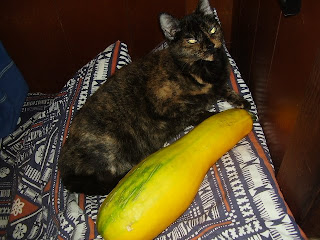Let me set the scene for you: I was reading the Vegenomicon (huge Vegan cookbook, I’m not vegan but was still intrigued) and came across an entry on agar-agar, a seaweed used in Asian cooking which acts as a gelatin substitute. I was interested in trying it so when I went to a local health food store I looked for it and found it…except they wanted eight bucks for a tiny package that would have only thickened about 4 cups of liquid! That makes it very expensive per pound. (Needless to say I didn’t buy any.)
Flash forward a few weeks and we are at the Chinese American Mini Market (which is actually a rather large Asian grocery in Providence) and they have agar-agar much, much cheaper. (Needless to say I buy two bags.)
The lesson here is that if you are looking for hard to find ingredients for Asian cooking they will probably be very overpriced, that is unless you go to an Asian market. That is why, despite the ridiculous cost of gas these days; we still shlep to Providence every couple months to shop at the Asian markets there.
Although we had recently stocked up at the Asian American Mini Market our pantry was still missing a few ingredients (mostly Japanese which the Chinese American Market is not strong on) so we ventured to Asiana in East Providence (good for Japanese and Korean ingredients) and Asian Star Market in Providence (for southeast Asian ingredients).
(I say ventured as if we took a leisurely drive. It was actually quite frustrating since every exit we had planned to take was closed and we had to re-plan our route mid trip several times. That’s Rhode Island roads for you. Thanks Cardi Corporation!)

We bought: dried anchovies, what was hopefully kelp but definitely some sort of seaweed (the packaging at Asian markets can often be rather short on English), dried bonito shavings (the first three things are for soup stock), roasted barley tea (an experiment), sesame seeds, adorable little green Thai eggplants (couldn’t resist), wet seedless tamarind paste (tastes like very tart raisin paste, so far the only thing I use it for is tamarind martinis), chocolate and marbled green tea Pocky (an awesome candy, they are like dipped pretzels, a treat for my boyfriend), three bunches of lemon grass (most of which we will freeze), dark soy sauce, fish sauce, whole black pepper, Japanese noodles, Korean noodles and green tea buckwheat noodles.
Although Japanese noodles are not really frugal in the sense that they are actually quite expensive as far as pasta goes, they are cheaper if you buy them at an Asian market (and having them is not optional, we make Japanese soup with soba noodles on a fairly regular basis).
We usually use one of two broth recipes:
Dashi: seaweed (kelp) and bonito (dried fish) flakes which we can mixed with either miso paste or chicken stock (preferably homemade, western style stock with seasonings like parsley don’t really work).
Strong stock: seaweed (kelp), dried anchovies (heads removed), dried mushrooms, soy sauce, sake and sugar.
Although you can put lots of things in the soup like chicken, veggies, egg, or tofu we have learned from experience that if you are going to use noodles it is easier to cook them separately. When they are done drain them and toss with some sesame oil so that they will not get overcooked languishing in the soup while you are waiting for everyone to eat.
And a great way to use up any excess cucumbers from the garden is to make a simple cucumber salad to accompany your soup. Place sliced cucumbers with a generous sprinkling of salt in a dish and let sit for five mintes. Then rinse them and dress with rice wine vinegar and sugar and let sit for another hour or so.
I don’t want to hear any complaints that it’s too hot for soup, try it, its damn good!






 (This is what 21 pounds of tomatoes which are ready to have their skins removed looks like. Please ignore the mess of assorted vinegars and oils in the background which never seem to make it back to the cabinets they supposedly belong in.
(This is what 21 pounds of tomatoes which are ready to have their skins removed looks like. Please ignore the mess of assorted vinegars and oils in the background which never seem to make it back to the cabinets they supposedly belong in.

















 (Bread and butter on the left, dill slices on the right)
(Bread and butter on the left, dill slices on the right)



